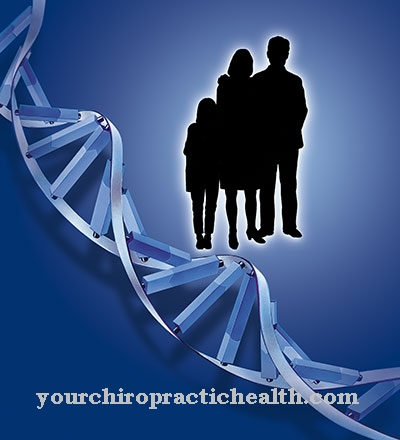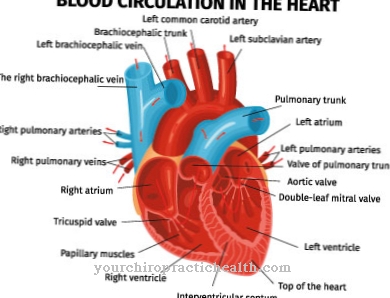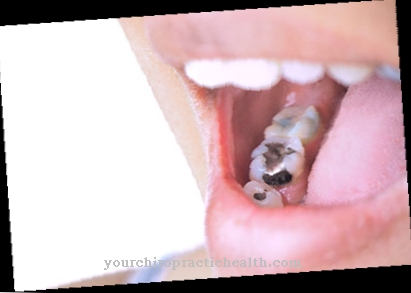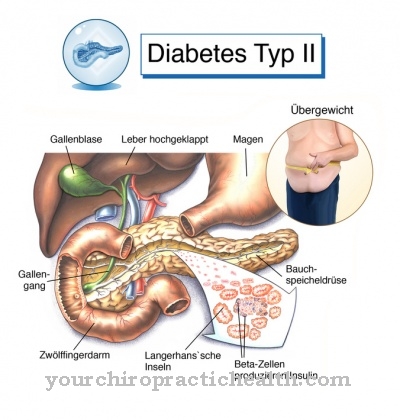The disseminated intravascular coagulopathy is a coagulation disorder and a life-threatening condition that is associated with a tendency to bleed. The disease triggers are diverse and range from trauma to carcinoma. The prognosis and therapy depend on the underlying disease.
What is disseminated intravascular coagulopathy?

© Евгений Вершинин - stock.adobe.com
The intrinsic system consists of blood platelets, the vascular endothelium, the external vascular tissue and the coagulation factors. The system is activated in the event of injuries and initiates blood clotting. This creates the so-called coagulation cascade, which results in a plug of fibrin and closes the wound. Coagulopathies are disorders of the intrinsic system.
They are divided into minus coagulopathies with an increased tendency to bleed and plus coagulopathies with a tendency to thrombus formation. Coagulopathy is also disseminated intravascular coagulopathy. This is a potentially life-threatening condition with a tendency to bleed. In this disease, excessive blood clotting takes place in the blood vessel system, which uses up important clotting factors.
For blood coagulation in the event of injuries, these coagulation factors are no longer or only insufficiently available due to the consumption in the vascular system. This form of coagulopathy is an acquired condition belonging to the group of vasculopathies. These are non-inflammatory vascular diseases with vascular occlusion.
The medical terms are synonymous with the term disseminated intravascular coagulopathy Consumption Coagulopathy and Defibrination Syndrome used. The disease consists of three phases: a pathological activation of the coagulation system, a recognizable deficit with regard to the coagulation potential and a defibrination phase.
causes
Consumption coagulopathy usually arises as part of a serious underlying disease. A distinction is made between three groups of trigger mechanisms: In addition to the rapid infiltration of prothrombin activators, the cause may be massively active plasmatic blood coagulation via an endogenous route or mediator-mediated coagulation activation. This makes shock caused by trauma, hypovolemia and gram-negative sepsis, for example, conceivable causes of disseminated intravascular coagulopathy.
Snake venom or complications during childbirth can also be the cause. The most important causes in the area of birth complications include the premature detachment of the placenta and amniotic fluid embolism. Surgical interventions on the prostate, pancreas or lungs, which are associated with an increased release of prothrombin activators, can also be the cause of consumption coagulopathy.
Consumption coagulopathies can also occur in the context of the Waterhouse-Friderichsen syndrome. The reason for this is the gram-negative endotoxin exposure associated with the disease. In addition, infections are a possible trigger for disseminated intravascular coagulopathy. In the event of transfusion incidents, massive hemolysis can also occur, which can just as easily lead to consumption coagulopathy.
Malignancies can also be used as a framework for the coagulation disorder. The phenomenon was observed particularly frequently after rapid breakdown of the malignancy. During operations using a heart-lung machine, the extracorporeal circuit can also cause disseminated intravascular coagulopathy.
Symptoms, ailments & signs
In the first stage of pathological activation, no deviation from the healthy norm can be seen in patients with consumption coagulopathy. The pathological process is nonetheless already under way. TFPI and antithrombin are used up in the vascular system. The coagulation-promoting effect of different components of the coagulation cascade initiates the disseminated intravascular coagulopathy. There is a pathologically high level of messenger substances in the body.
In addition to histamine and serotonin, the increase can affect adrenaline, for example. Small blood clots form in the blood capillaries, arterioles, and venules. The blood vessels in the lungs, kidneys and heart become blocked. Liver function can also be impaired. In the second stage of the disease, platelets, coagulation factors and inhibitors drop sharply because they are consumed intravascularly. As a result, fibrinolysis occurs.
The values of the fibrin breakdown product are increased and the value for fibrin falls. Due to the non-directional clotting in the vessels, blood components that are necessary for blood clotting are consumed. Deficiency symptoms occur primarily with regard to platelets, fibrinogens and coagulation factors. The organism can no longer close damaged blood vessels itself and a hemorrhagic diathesis occurs. This is followed by the defibrillation stage.
In addition to the thrombocytes and coagulation factors, the antithrombin is now also reduced. The symptoms of deficiency express themselves clinically in the form of a shock, which is associated with multiple organ failure due to thrombi or a tendency to bleed. Spontaneous bleeding without injury can be observed on the skin and in various organs.
Diagnosis & course
The diagnosis of consumption coagulopathy is made on the basis of laboratory parameters such as D-dimer, platelet count and the Quick value. In addition to thrombocytopenia, there is a prolongation of the PTT, a decrease in the Quick value and a decrease in antithrombin III. In addition, a consumption of fibrinogen can be observed, which is associated with the proteolytic activation or degradation of other coagulation factors.
The prognosis depends crucially on the cause, the therapeutic options and the complications. With associated symptoms such as kidney failure, the prognosis is rather poor.
Complications
As a rule, the disease is a relatively dangerous condition for the patient, which must be treated in any case. Without one, in the worst case scenario, death can occur. Blood clots form, which can block the blood vessels as the disease progresses. Thus, there is less blood flow to the heart and kidneys.
In most cases, the body can no longer close the damaged blood vessels itself, which can lead to a life-threatening condition. Individual organs can fail and the patient dies. The diagnosis of the disease is relatively simple and clear, so that treatment can be started quickly.
Usually, treatment is done with the help of medication and blood transfusions. This results in a positive course of the disease. For the patient, however, a relatively long stay in the hospital is necessary, whereby the quality of life is greatly reduced. Even after healing, the person affected must take it easy and must not engage in heavy physical activities or sports. With successful treatment, life expectancy is usually not restricted.
When should you go to the doctor?
If signs of bleeding appear after a shock, extensive burns, trauma, or severe sepsis, consumption coagulopathy may be present. This condition, also known as disseminated intravascular coagulopathy, also occurs with complications at birth, preeclampsia, eclampsia and amniotic fluid embolism.
Likewise for blood poisoning and complications of surgical interventions on the heart, lungs and internal organs. In most cases, the attending physician will determine the consumption coagulopathy himself and initiate the necessary medical measures.
In the chronic form, those affected can sometimes independently determine the disseminated intravascular coagulopathy based on the symptoms. Patients with cirrhosis of the liver, heart defects, metastatic carcinoma, or haemoblastosis should consult a doctor if bleeding increases or signs of bleeding anemia occur.
Since disseminated intravascular coagulopathy is almost always life-threatening, an emergency doctor must be called in any case. Patients already under treatment should inform their nursing staff or doctor if they suspect it. He will conduct an examination and, if necessary, initiate treatment directly.
Doctors & therapists in your area
Treatment & Therapy
Manifest, but early consumption coagulopathy is associated with reversible functional disorders of the liver, kidneys and lungs. One of the most important treatment options at this stage is heparinization. If the platelet count drops threateningly, thrombosis and the tendency to bleed must be considered as therapy complications. In this case, heparinization should only be used moderately.
In the later stages of severe consumption coagulopathy, organs such as the lungs or kidneys experience shock reactions. The hemoglobin concentration drops. Fragmentocytes form until there is an almost absolute lack of fibrinogen. The heparinization is moderate in this phase. An antithrombin III concentrate is given in the event of bleeding. If the Quick values are below 30 percent, PPSB is administered.
The administration of fibrinogen concentrates is also possible at concentrations from 0.1 g / l. Anemia is treated with a blood transfusion at this stage. Fresh frozen plasma and factor concentrates are a final and relatively controversial treatment option. One of the more new therapeutic approaches is the administration of recombinantly activated protein C, which is active as a coagulation inhibitor.
The first preparations from this area had to be withdrawn from the market due to bleeding complications. The future will produce possibly applicable preparations in this area. In some countries, antifibrinolytic drugs are given for consumption coagulopathy. This step is considered controversial in Germany.
Outlook & forecast
Disseminated intravascular coagulopathy is a life-threatening condition that can be acquired as part of various underlying diseases. The prognosis for this disorder depends on the cause. Fatal courses result both from the increased formation of thrombi and from an increased tendency to bleed in the later stages of the disease.
In the first stage, microthrombi are formed that either remain symptom-free or lead to damage to various organs that are supplied by arterioles, venules or blood capillaries. These include the heart, kidneys, lungs, liver or adrenal glands. This stage can still be controlled by treatment with heparin, because this reduces blood clotting, but there are still enough platelets available.
If, in a second stage, the number of platelets is greatly reduced due to their high consumption, there is an increased tendency to bleed. The use of heparin is contraindicated here, as it only increases the bleeding tendency. Here, the prognosis is mainly based on the treatment options for the underlying diseases.
The third stage of disseminated intravascular coagulopathy is characterized by the full picture of shock. In addition to multiple organ failure due to embolism, there is increased bleeding. Spontaneous bleeding occurs in various organs. In this phase, the patient's survival depends on the therapeutic control of the underlying diseases and complications.
prevention
Disseminated intravascular coagulopathy and its complications can be prevented by doctors through daily monitoring of coagulation values in patients at risk. Patients with risk factors are given heparin as a preventive measure.
Aftercare
In most cases, the person affected has no direct measures or options for follow-up care. The affected person is first of all dependent on a comprehensive diagnosis and treatment of this disease, as otherwise death or other serious complications can result. Therefore, early diagnosis with early treatment is in the foreground with this disease, as self-healing cannot occur.
The further course depends very much on the exact underlying disease, which of course must be treated and avoided. The treatment itself takes place with the help of medication and blood transfusions. The affected person is dependent on regular transfusions to alleviate the symptoms.
When taking the medication, it should be noted that it should be taken regularly and that the correct dosage should be observed. If you have any questions or are unclear, you should always consult a doctor first. The support and loving care of friends and family is also very important with this disease so that treatment is accelerated. In many cases, however, the patient's life expectancy is significantly reduced by this disease.
You can do that yourself
Disseminated intravascular coagulopathy occurs in people who are normally already receiving medical treatment for a serious illness. The organism is already weakened and medical care is taking place.
Due to the circumstances, the possibilities for self-help are aimed at improving the well-being in the situation, as healing on one's own is unlikely. To follow the instructions of doctors or nursing staff. Changing the treatment plan on your own responsibility is not recommended as complications can arise.
A fundamentally positive attitude towards life helps those affected to better cope with the adversities caused by the disease. The joy of life should also be strengthened within the scope of the possibilities during this time. Conversations with people you trust or an exchange with other sick people can help to talk about emotional stress and to reduce fears. If professional help is required, a psychologist should be sought.
The diet should be balanced and healthy so that the body's immune system receives enough nutrients and vitamins. Food intake plays a decisive role in supplying the organs and stabilizing the organism. Therefore, the consumption of healthy foods is of fundamental importance, even with complaints such as loss of appetite.









.jpg)



.jpg)



.jpg)







.jpg)


